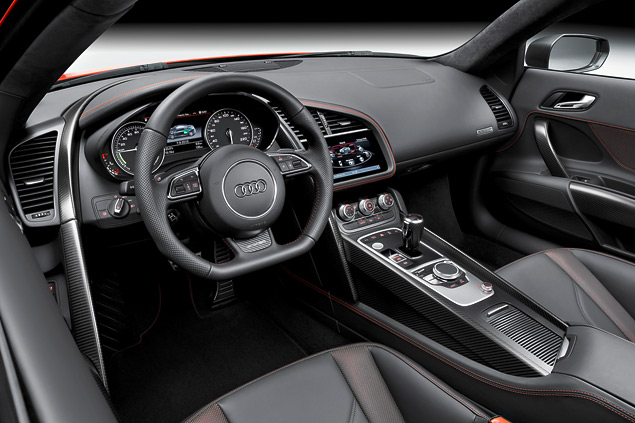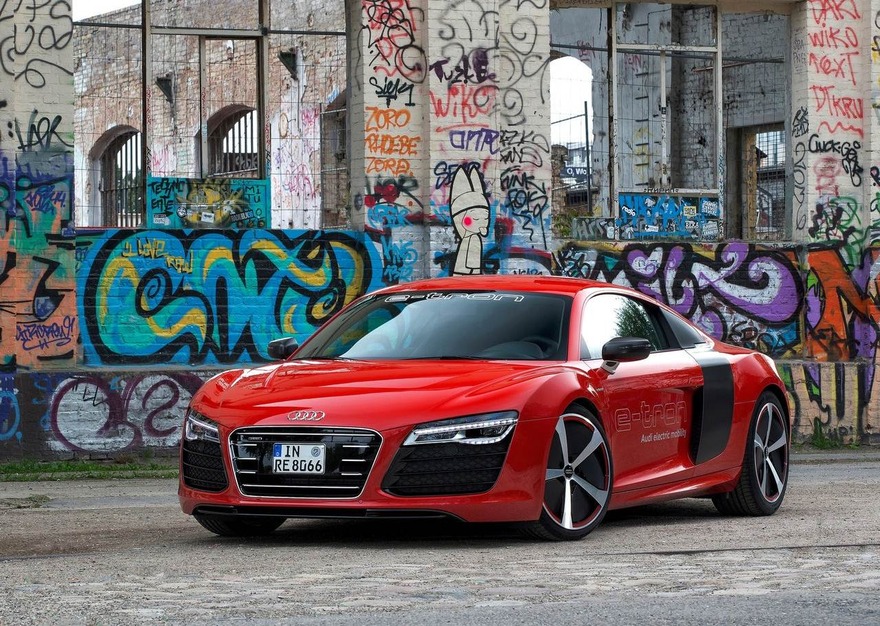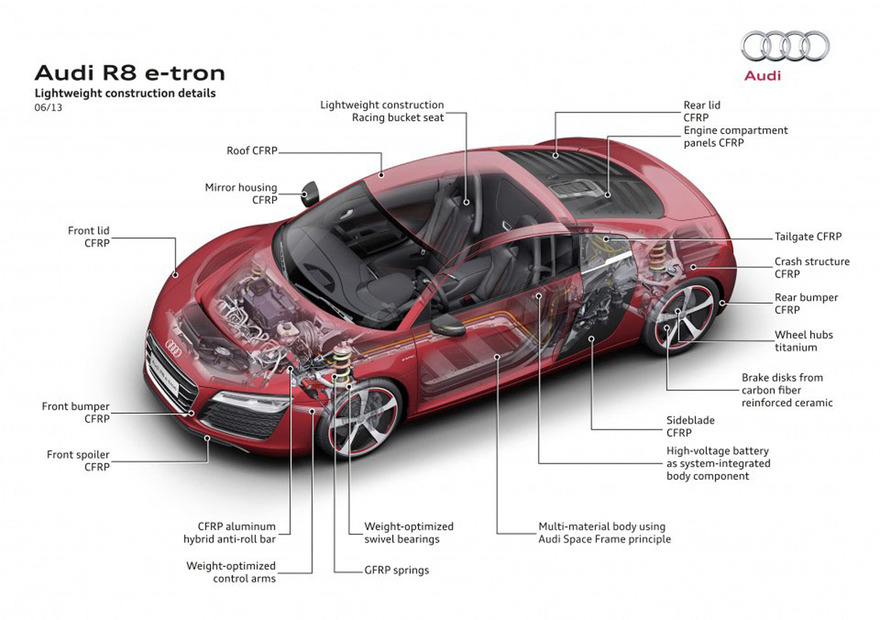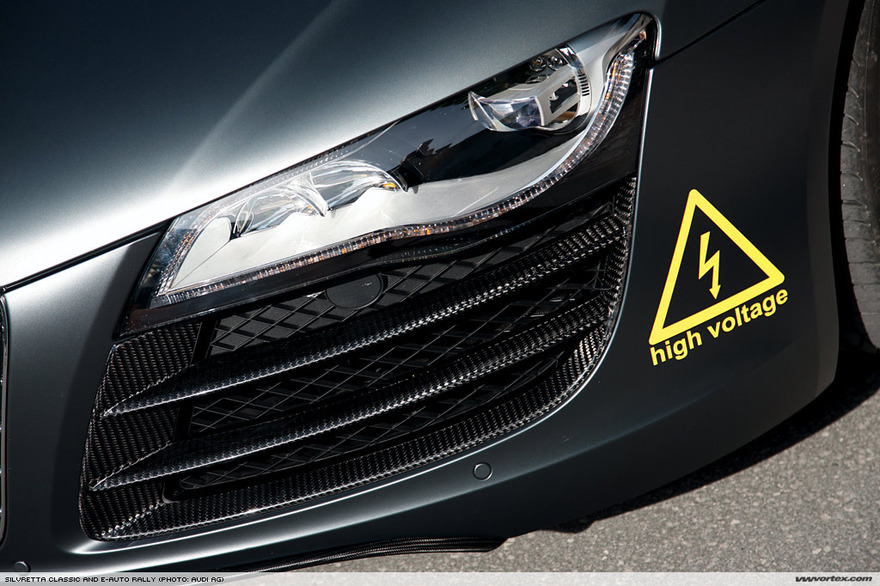The German car manufacturing company Audi AG (Volkswagen Group automotive company) was the last among its major German competitors — Mercedes and BMW — to take part in the ‘ecological arms race’. Only back in 2009 Audi demonstrated a 3D model of an e-tron concept car, which was its first ‘weapon’; and a bit later, at the Frankfurt Motor Show, the company revealed its ‘real’ copy.
The eco-concept is based on the standard R8 sports car. However, lack of harmful emissions is not the only advantage of the R8 e-tron — there is not a trace of metal to be found in its springs, brakes do without brake fluid, and the vehicle doesn’t need a gearbox.
What’s inside?
Audi R8 e-tron is a two-seat coupé with rear-wheel drive layout. Two electric motors delivering 380 hp and 820 Nm of torque are mounted on the supercar’s rear axle allowing it to sprint to 100 km/h in 4.8 seconds.
The exterior of the R8 e-tron is similar to the one of the production model but these two cars are very different inside. The weight of the Audi R8 e-tron is 1,780 kg. Materials used by the engineers were as light as possible to lower down the weight of the prototype — it features specially designed aluminium chassis, most of the body panels and anti-roll bars are made of carbon fibre, and even the suspension springs are made of fiberglass-reinforced polymer.
The heaviest part of the powertrain is the battery. The T-shaped battery pack consists of 530 prismatic cells; it is more than 2 m long and weighs 577 kg. The cooling fluid circulates through narrow channels cut into the block, with a total length of 700 meters. The battery pack has a total capacity of 48.6 kw/h. The full energy potential of the battery is restored in 6–8 hours; however, a special high voltage station reduces this to just around 2.5 hours. The battery charge is good for an operating range of only 215 km. As a comparison, Tesla Model S electric car, which has lower manufacturing cost and bigger weight, can travel the distance of around 500 km.
The electric motor delivers its peak torque at zero rpm. In order to avoid wheelspin at low speeds, the car is fitted with ‘smart’ electronics providing a smooth start. Although the R8 e-tron is capable of accelerating to 250 km/h, its top speed was electronically limited at 200 km/h as the electricity consumption rises dramatically at high speeds.
Due to its specific layout design, the R8 e-tron has a lower centre of gravity than the standard R8, improving its performance and handling. Continental has developed special narrow tyres with reduced rolling resistance in order to increase the car’s travel distance — 225/35 R19 at the front and 275/35 R19 at the rear.
The electric Torque Vectoring system constantly changes the amount of torque sent to each rear wheel at several thousand times per second. That is why if the car goes too fast when entering the corner, the wheels will turn further preventing the car from sliding. This system receives data from multiple sensors mounted in the car. Audi’s engineers describe this torque control system more like protection from inadequate driving behaviour than some form of warranty against serious driving mistakes.
The car has an unusual braking system — carbon ceramic brakes featuring 6-piston callipers in the front and 4-piston callipers in the rear. Rear brakes are supplied with electric generators, so the front brakes are controlled by the brake pedal, while electronics is in charge of the rear brakes.
Audi attached paddles to the steering wheel of the R8 e-tron to control regenerative braking. Similar paddles shift gears in regular cars, while here they vary the amount of regenerative braking when stepping on and releasing the accelerator pedal.

The active aerodynamic elements like active-shutter wheels provide ideal temperature conditions for the braking system. The shutters are also controlled with the help of multiple sensors. This feature improves the car's drag coefficient to 0.27.
The visionary electric coupé uses Car-to-x Communication multimedia system, which interacts with the outside world, receives data about the situation on the road — traffic, congestions, traffic-lights schedule, and many other things.
The price
Audi R8 is a rather expensive car. The price of the current generation of the R8 starts at more than 5 million RUB (approx. €105,000) for a coupé-bodied version. Spyder R8 costs not less than 6 million RUB (approx. €126,000). A GT version fitted with 5.2-litre engine delivering 560 hp can be purchased at the price of more than 8 million RUB (approx. €168,000). What concerns the price of the 2014 Audi R8 e-tron, it is expected to start at about 9 million RUB (approx. €188,600).
When is it expected to arrive?
The pre-production version of the supercar was revealed in 2010 and the launch of its production was scheduled for 2012. Then, basing on the decision made by Audi's head of research and development Wolfgang Dürheimer, the company put the project of producing an electric R8 on hold. At the time of writing this article (May 2014), only 12 electric e-tron prototypes saw the light of day. It turned out that the company had spent more than a million euros to build each of them. Production of batteries is a very costly affair and that is why the project has been scrapped.
However, in June 2013 Dürheimer was replaced by Ulrich Hackenberg and the project was given a new lease of life. After resuming the work on the e-tron model, the travel distance of the car was increased from 215 km to almost 400 km. Finally, the company’s management has confirmed production plans for the e-tron.
There is no word yet on the arrival date of the production 2014 Audi R8 e-tron. It is due in the European market late in 2014 and in the U.S. market early in 2015. The next-generation car will feature a lighter body than the one of its predecessor and more a powerful engine lineup — V8 (450 hp) and V10 (550 hp).
Interesting to know
— One of Audi R8 e-tron prototypes entered the 2010 Silvretta E-Auto Rally Montafon driven by the Audi factory driver Lucas Luhr. The R8 e-tron won the race against 23 other electric cars in the three-day race.
— Approved by Tony Stark. Due to advanced technologies and the luxury of Audi’s design, the R8 e-tron supercar was included in the movie Iron Man 3.














